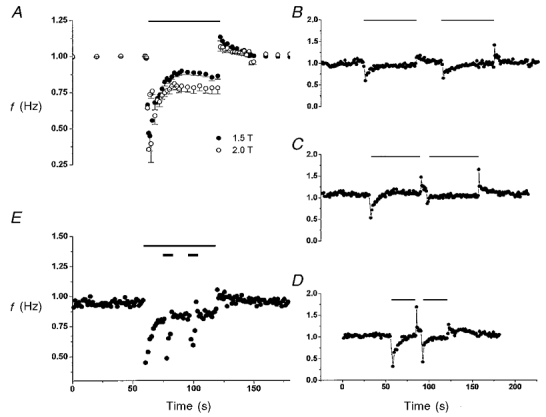Figure 3. Criteria for habituation of Hering-Breuer reflex in terms of the recovery pattern of respiratory frequency (f) with varying vagal stimulation protocols (indicated by different horizontal bars; stimulation frequency, 80 Hz).

A, rate of recovery was inversely dependent on stimulation intensity. Data show mean responses (n = 3) to 1 min vagal stimulation at two different stimulation intensities (1.5 and 2.0 × T). B, recovery patterns were similar in consecutive 1 min vagal stimulation episodes separated by a 30 s intermission period in one rat. However, the group data in three rats showed that the magnitude of the initial inhibitory response at onset of the second episode was slightly lower (-15 ± 1.15 %) than that of the first episode, suggesting some residual effect of the habituation from the first episode. C, inhibitory effect of vagal stimulus was diminished in the second stimulation episode when the intermission period was shortened to 5 s. The magnitude of the initial inhibitory response was markedly decreased (-45 ± 10 %, n = 3) in the second episode compared with the first episode, suggesting that the residual effect from the first episode (see B) represents a time-dependent short-term memory. D, the short-term memory of habituation became less pronounced when the duration of the first vagal stimulation episode was shortened by half. The initial inhibitory response in the second episode was not significantly different (-8.0 ± 7.7 %, n = 3; P > 0.1, t test) from the first one. E, dishabituation and habituation of dishabituation. Thin and thick bars indicate the stimulation of the first and second vagus nerves (at a stimulation intensity of 1.5T and 4T, respectively). Note that strong stimulation of the second vagus nerve reversed (‘dishabituated’) the habituation of the response to stimulation of the first vagus nerve as evidenced by the pronounced response evoked by the second vagal stimulus. However, the response to the second vagal stimulus was diminished (i.e. habituated) when the stimulus was applied a second time. Thus, the dishabituation effect of the second vagal stimulus was itself habituated.
